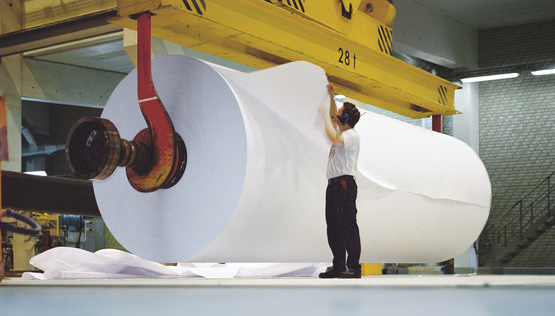 As the pulp and paper industry enters a new era, Linde is poised to become a strategic partner, offering technologies to increase efficiency and minimize the environmental footprint.
As the pulp and paper industry enters a new era, Linde is poised to become a strategic partner, offering technologies to increase efficiency and minimize the environmental footprint.
Faced with ubiquitous reminders to “think before you print”, one would expect the pulp and paper industry to be struggling. Yet far from it. After years in the doldrums and despite digitalisation, this industry is set to see strong growth in most of its sectors except graphic paper.
“Packaging is growing all over the world, along with tissue papers, and pulp for hygiene products”, McKinsey observed in May 2017. The consultancy expects consumer packaging and tissue sales to grow roughly on par with GDP and industrial packaging slightly below GDP. Key drivers are the growing use of home delivery services and emerging countries’ increasing demand for convenience products such as tissues.
While this is good news for the pulp and paper industry, the coming years will also bring significant change. McKinsey forecasts “the most substantial transformation” the sector has seen in decades. In the wake of declining newspaper circulations, paper mills need to convert from graphic to packaging paper. Executives should also reduce costs, establish new ways of cooperating and invest in research and development for biorefinery products, the consultants recommend.
Shaping up for the future
With a profound understanding of the industry and a long list of relevant patents, Linde is poised to become a strategic partner as the pulp and paper industry rises to these challenges. ”We provide custom-tailored, gas based solutions for process improvement as well as reliable gas supply in suitable modes,” says Ann-Charlotte Jansson, a pulp and paper expert with Linde. “Thanks to our deep process knowledge, we help customers to solve production-related problems or increase the mill’s productivity in an eco-friendly way.”
To this end, Linde offers a multitude of solutions and technologies based on carbon dioxide (CO2). Take ACTICO® CO2 pulp wash technology, for example. It boosts mills’ pulp washing efficiency by adding CO2 and thereby significantly increases their capacity without the need to invest into new and larger washing equipment. The CO2 slightly reduces the pH value, but leaves it at alkaline levels. As a result, some of the charged groups of the pulp fibres are protonated and therefore less repellent. “This results in less swollen fibres and more water is released from the fibres,” says Jansson.
Control over pH levels and pH stability are essential in modern paper machines, as pH influences most unit operations. Experts at many mills believe that maintaining a stable pH is even more important than obtaining a precise pH level, since paper machines are much easier to optimize under stable conditions.
The ACTICO® CO2 pulp wash technology is adapted to customers’ challenges according to their specific process parameters. While the benefits are ultimately dependant on the individual mill, they include improved dewatering, less wash water usage and less foaming. ACTICO® CO2 pulp wash can also smooth a mill’s transition from paper to cardboard. In the case of one Linde customer, this conversion changed the produced pulp from bleached to unbleached. Linde’s ACTICO® helped achieve the desired production.
Decreasing demand in the Western hemisphere is more than offset by demand growth in Eastern countries. Source: asiapapermarkets.com
Control over pH levels by processes such as ACTICO® pH control and ADALKA® process stabilizer create stable conditions, which are a prerequisite for optimizing paper machines.
Another example of a successful Linde solution is the ADALKA® process stabilizer. This process provides a buffering solution, formed by a combination of CO2 and caustic soda (NaOH) to regulate and stabilize pH, alkalinity and calcium levels in the papermaking process. This helps to decrease deposits in the paper machine and thereby extends the maintenance intervals.
CO2 is both more user-friendly and more favourable environmentally than many of the mineral acids it can replace. Its characteristics as a weak acid also have many other benefits in complex chemical systems like the wet end of a paper machine. Captured from exhaust fumes for example in the petrochemical industry, Linde’s CO2 is cleaned and compressed before being re-used. Small but important steps like this can help reduce the overall CO2 footprint.
Wood instead of plastics
Yet one of the most important fields of innovation is biorefinery. In an effort to seek new resources and increase efficiency, the pulp and paper industry is looking at forest biorefinery. “By integrating forest biorefinery activities at an existing plant, pulp and paper mills have the opportunity to produce significant amounts of bioenergy and bioproducts,” writes industry researcher Pratima Bajpai in Biotechnology for Pulp and Paper Processing. Chemicals and pharmaceuticals can be produced from a tree’s bark and other forest residuals; biofuels can be generated from lignin, which is a by-product of pulp production. Making use of such opportunities could “expand the industry’s mission from simply manufacturing low margin products to creating new revenue streams by producing ‘green’ power,” according to Bajpai.
Industry players are putting such technology to good use. The global forestry-products company Stora Enso recently launched a wood-based alternative to oil-derived plastics. The wood fibres, mixed with oil-based polymers and other additives, look a little like popcorn, according to the Economist. Yet they can be melted and moulded like plastic.
Linde supports the move into biorefinery by – among other things – providing gaseous nitrogen to assess the tightness of pipelines or to cool down reactors. “We also provide hydrogen, create inert atmospheres and offer solutions to reduce fire hazard,” says Paolo Kirchpfening, Linde’s marketing manager for Chemicals and Environment. “The pulp and paper industry is ideally positioned to use wood, a re-growing resource, to provide alternatives for oil-based products. Linde is keen to support that.”
www.linde-gas.com